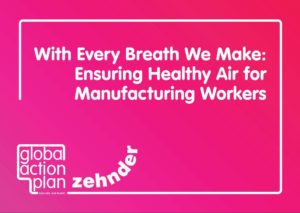Up to 440,000 workers with health conditions that are worsened by air pollution are still being exposed to unhealthy levels of airborne hazards and pollution; regulation limits are too weak and are not being enforced, according to a new whitepaper.
 A new whitepaper by Global Action Plan and Zehnder Clean Air Solutions has discovered that the quality of the air in the manufacturing sector continues to be underplayed and not acted upon with workers in the UK still being exposed to unhealthy levels of airborne hazards and pollution. The whitepaper further presents a renewed case for tackling air pollution in industry workplaces with urgent actions for policy makers, regulators and manufacturers.
A new whitepaper by Global Action Plan and Zehnder Clean Air Solutions has discovered that the quality of the air in the manufacturing sector continues to be underplayed and not acted upon with workers in the UK still being exposed to unhealthy levels of airborne hazards and pollution. The whitepaper further presents a renewed case for tackling air pollution in industry workplaces with urgent actions for policy makers, regulators and manufacturers.
The whitepaper, entitled “With Every Breath We Make: Ensuring Healthy Air for Manufacturing Workers”, identifies:
- An estimated 440,000 workers with health conditions that are exacerbated by air pollution are still being exposed to unhealthy levels of airborne hazards and pollution in manufacturing workplaces;
- The presence of airborne hazards causes production issues, product quality and that impacts profit margins;
- Current regulation allows levels of airborne hazards and pollution that are dangerous to manufacturing workers’ health;
- Regulation enforcement is not meeting the necessary standards.
Urgent action is said to be required to protect workers who are unable to work remotely given increasing evidence shows that poor air quality worsens underlying health conditions that make a person more vulnerable to complications if they contract COVID-19 and workers in the manufacturing sector are at greater risk of being exposed to dust, toxic particles and pollution.
The whitepaper is supported by the Trade Unions Clean Air Network (TUCAN) and the Hazards campaign, who have called on the government to update regulation to lower the acceptable limits for air pollutants in the industrial workplace, echoing the call from the Institute of Occupational Medicine (IOM) and Trades Union Congress (TUC) that limits be changed to 1mg/m3 for respirable dust from the current 4mg/m3 COSHH trigger.
In addition to the government call, the whitepaper further advises that regulators review exposure limits of all air pollutants, beyond current regulation and in line with new research which finds that airborne hazards can cause health conditions including heart attacks, cancer, diabetes, cognitive function, and depression. This includes launching long-term research programmes which combine air quality monitoring in manufacturing sites with tracking of workforce health issues.
Manufacturers are also urged to review the business case for action on air pollution, with help from the authorities and adopt measures to eliminate airborne pollution.
Hilda Palmer, Hazards Campaign and the Trade Unions Clean Air Network (TUCAN) said: “The full harm and inequalities to workers caused by toxic chemicals and dust in workplace air is not captured by official figures but is enormous, killing tens of thousands each year, making hundreds of thousands seriously ill. Trade union safety reps using their full legal rights to consultation, involvement in risk assessments and safe systems of work, have reduced workers exposure to many toxic substances, and made union organised workplaces far safer and healthier.
“We welcome this initiative to increase the rights of all workers to reduced exposure levels and increased enforcement of health and safety law, especially the control hierarchy of the Control of Substances Hazardous to Health, COSHH, Regulations. Workers and trade unions are at the forefront of the fight to eliminate and substitute harmful substances first, use effective engineering controls, administrative controls next, and PPE only as a last resort.
“Trade unions in TUCAN want to create cleaner jobs for all workers and citizens by removing unequal exposure to the toxic substances that kill and make them ill.”
Approaches to managing the risks associated Musculoskeletal disorders
In this episode of the Safety & Health Podcast, we hear from Matt Birtles, Principal Ergonomics Consultant at HSE’s Science and Research Centre, about the different approaches to managing the risks associated with Musculoskeletal disorders.
Matt, an ergonomics and human factors expert, shares his thoughts on why MSDs are important, the various prevalent rates across the UK, what you can do within your own organisation and the Risk Management process surrounding MSD’s.

 A new whitepaper by Global Action Plan and Zehnder Clean Air Solutions has discovered that the quality of the air in the manufacturing sector continues to be underplayed and not acted upon with workers in the UK still being exposed to unhealthy levels of airborne hazards and pollution. The whitepaper further presents a renewed case for tackling air pollution in industry workplaces with urgent actions for policy makers, regulators and manufacturers.
A new whitepaper by Global Action Plan and Zehnder Clean Air Solutions has discovered that the quality of the air in the manufacturing sector continues to be underplayed and not acted upon with workers in the UK still being exposed to unhealthy levels of airborne hazards and pollution. The whitepaper further presents a renewed case for tackling air pollution in industry workplaces with urgent actions for policy makers, regulators and manufacturers.
Those interested in controlling airborne health hazards in manufacturing should visit the British Occupational Hygiene campaign website.